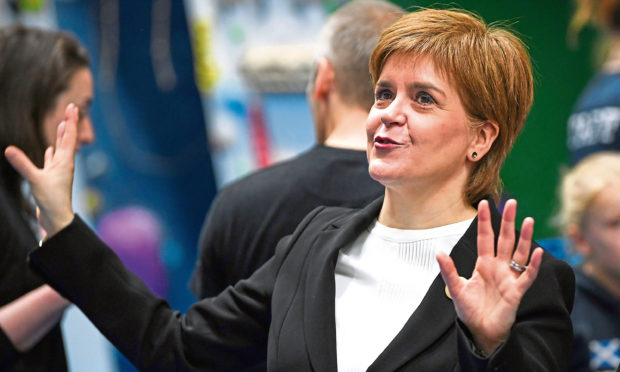If anyone was in any doubt about Nicola Sturgeon’s true intentions regarding her Brexit strategy, all was revealed on Monday morning during a deeply troubling radio interview.
Scotland’s first minister did little to disguise the fact that she is determined to hold a second independence referendum – quite possibly within the lifetime of this parliament.
Her justification for ignoring the will of the Scottish people – who decisively rejected the nationalists’ call for separation in 2014 – is Europe.
But, as she made clear on the BBC’s Good Morning Scotland programme, her motivation is not to stay in the EU but to leave the UK.
Sturgeon has spent the past two and a half years, since the 2016 Brexit vote, trying to link Europhile Scots, who voted by a significant majority to remain in the EU, with her independence cause.
She figured that all those who could not be convinced by Scottish nationalism in 2014 would change their minds in the wake of the UK-wide Brexit decision.
But she was wrong. Poll after poll has shown no shift at all in Scottish support for the union, and the ‘Brexit bounce’ so longed for by the SNP leader has failed to materialise.
So why launch a new drive now to force the issue? Although she didn’t actually announce a date for Indyref2, she hinted that she wouldn’t wait until the next Holyrood elections in 2021.
“There is a mandate to have a referendum within this term of the Holyrood parliament,” she said, adding that the Scottish Government had “every right” to fulfil that mandate.
This may sound like her familiar refrain, but it is more than that; it’s as if she has made a New Year’s resolution to spell out her referendum agenda, then clamped her hands over her ears to drown out what she knows will be her fellow Scots’ opposition.
Those of us concerned about nationalists’ disregard for popular opinion hoped, perhaps naively, that Sturgeon’s political experience would prevail, and we would not be dragged into further constitutional disruption while there was no chance of a separatist victory.
But the first minister appears to be banking on nationwide malaise over the way Brexit has been handled and gambling on harnessing this to her own ends.
Everything that has happened over the last two years “has strengthened and reinforced the case for Scotland to be independent” she said.
She blamed the Brexit vote – which included one-third of her own SNP constituency – on dissatisfaction with “UK Tory austerity”, a cloth-eared response to such a complex crisis.
And she insisted that Scotland’s interests could not be protected within the “current set-up in the UK”, but she then defined Scotland’s interests as being independent.
This is not the first time, of course, that she has confused her party’s priorities with Scotland’s, but after all her years in office she seems wilfully ignorant of what her country wants.
“The simple fact is that the overwhelming majority of people in Scotland voted to remain in the EU,” said Sturgeon, forgetting that the overwhelming majority of people in Scotland also voted to remain in the UK.
Her policy on Theresa May’s deal is to vote it down and then push for a second ballot on the EU. As she conceded, even if this did go ahead, the result might be the same as in 2016.
If she really cared for Britain’s continued EU membership, she could have brought her parliament – predominantly pro-Europe across all parties – together under a strong Remain umbrella and lobbied to Scotland’s (not the SNP’s) advantage in London.
But her one goal has been to disrupt the process from a partisan position. There is not much to be gained in holding a second debilitating EU referendum but it would certainly set a convenient precedent for the Scottish nationalists.
Who still thinks the SNP has Scots’ interests at heart? Sturgeon was reminded during her BBC interview about problems in education, with the looming threat of the first national strike by teachers since the 1980s.
And she was also asked about broken promises over waiting time guarantees in the health service, after one patient waited 849 days to receive treatment for cancer.
How can these things be happening if the SNP is putting Scottish people and their interests before politics?
That, Sturgeon could not answer. So she went back to her mantra – of Scotland’s powers being eroded (despite her government not using the powers it has, over welfare, for instance); of Scotland being spurned; of Scotland being ignored and sidelined.
This is not about Brexit, and it is not about Scotland.
It is the sound of the firing gun marking the beginning of the nationalists’ campaign for a second independence referendum, whether or not the rest of us want one. You have been warned.
